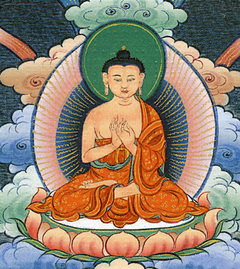Third Testament of the Buddha
Third Testament of the Buddha
from the Vima Nyingtik
In the language of India: buddha-dhekarayatri-nāma
In the language of Tibet: sangs rgyas kyi zhal chems gsum pa zhes bya ba
In the English language: The Third Testament of the Buddha
Homage to the self-liberated Vajradhara!
Kyema! Kyema! Listen, O children of noble family!
Physically, should you wish to pass beyond suffering,
Train in the postures of the three kāyas.
Whoever does so will pass beyond misery
In the expanse of the enlightened forms
Of all the buddhas of the three times.
Vocally, find stability in the phase of training,
And in abiding and then transcending.[1]
Whoever does not disregard this
Will pass beyond misery in the expanse
Of the enlightened speech of all the buddhas of the three times.
As the crucial point of mind, adopt the threefold gaze.
Toward an immaculate sky, the key point of the field,
Look up, down and to the side—the key of the gateway.
And, as the key of breath, train in very slow respiration.
Through the application of these three key points,[2]
Empty awareness with its three kāyas will dawn.
Hold captive the chains of awareness,
Key to the direct, and seeing will be inevitable.[3]
The vision of directly realizing dharmatā,
Causes speculative, fixated views to fade away. [4]
Through the vision of increasing experience,
The wisdom of the bardo is made manifest.
Through the vision of rigpa’s full measure,
There is recognition of the sambhogakāya.
Through the vision of exhaustion in dharmatā,
Great Perfection’s fruit, beyond action, is obtained.
If you can complete these four in this way,
There is no need to seek nirvāṇa elsewhere.
With the foundation of threefold immovability,
Measure progress based on the three forms of rest;
Indications will arise in body, speech and mind.
Drive in the nails of threefold attainment.
There is nothing further to be taught. Samaya!
Embrace this teaching, which has fallen to you
And is well inscribed with precious materials.
Whoever reveres it is sure to gain liberation.
Rainbow lights, the rumbling and quaking of the earth,
Frost, hail, famine and eclipse—at all such times,
To recite this text aloud in the appropriate direction
Will be of greater purpose than any offering made
To buddha emanations throughout a billion worlds.
This blessed text of spontaneously arisen blessings, a naturally arisen expression of all the teachings,[5] appeared when the Teacher demonstrated passing into nirvāṇa on Vulture Peak Mountain to the south of Rājgṛha and Garab Dorje cried out in anguish. It is the spontaneously arisen text made of five precious jewels, which descended into the palm of Garab Dorje’s right hand, the final testament of the Buddha, the sole heir of all the teachings. Samaya. Gya. Gya. Gya.
| Translated by Adam Pearcey with the generous support of the Tsadra Foundation, 2024.
Bibliography
Tibetan Editions
"sangs rgyas kyi 'das rje gsum pa" In snying thig ya bzhi. 13 vols. Delhi: Sherab Gyaltsen Lama, 1975. Vol. 3: 292–295
Version: 1.0-20241113
-
These are three distinct stages (Cf. sgra thal 'gyur: ngag ni bslab pa dang gnas pa dang/ la bzla ba nyid bstan par bya/). The stages are explained in Longchenpa’s Infinite Clouds of Profound Meaning (zab don rgya mtsho’i sprin). ↩
-
The Khandro Nyingtik version reads "Through the application of these four key points…" This would suggest that that text counts the key point of the mind separately, whereas here the three key points are subdivisions of the crucial point of mind. ↩
-
The Khandro Nyingtik version reads thog ldog pa med/ "… by means of which there will be no turning back." ↩
-
The Khandro Nyingtik version employs the imperative form snubs (Do away with!) in place of nub. ↩
-
The translation here is based on the Khandro Nyingtik version, which has bstan pa thams cad kyi rang rtsal in place of the Vima Nyingtik version’s bstan pa thams cad kyi rang babs. ↩
